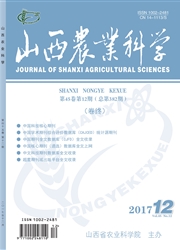

 中文摘要:
中文摘要:
为筛选适宜的菌渣肥配方和施用量,减轻农业副产物对环境的危害,提高农业生产的可持续性,以不施菌渣肥为对照(CK-JZ0),研究了小麦季施用不同菌渣、牛粪配比的菌渣肥(JZA(纯菌渣)、JZB(菌渣∶牛粪=1∶2)、JZC(菌渣∶牛粪=1∶1)、JZD(菌渣∶牛粪=2∶1))在3 000(JZ1),6 000(JZ2),9 000(JZ3)kg/hm~23个施用量水平上对下茬玉米产量的影响。结果表明,与CK-JZ0相比,只有在小麦季菌渣肥施用量为9 000 kg/hm~2的条件下,施用JZA-JZ3,JZB-JZ3,JZC-JZ3菌渣肥处理的下茬玉米具有较高的增产效果,2 a的平均增产幅度分别为1 071.5,1 443.5,707.5 kg/hm~2,不同配比菌渣肥对玉米的增产效果大小为JZB〉JZA〉JZC;同时,JZA-JZ3,JZB-JZ3菌渣肥处理的玉米株高、穗位高较高,而对玉米的干物质积累量、穗行粒数、单株籽粒质量的影响规律性不明显;JZC-JZ3菌渣肥对玉米生长的影响没有明显的规律性。
 英文摘要:
英文摘要:
In this manuscript, to obtain suitable edible fungus residue fertilizer applicable technology and reduce their harms to the environment, the effects of 4 kinds of edible fungus residue fertilizers which including JZA(pure edible fungus residue), JZB(edible fungus residue vs. dairy manure=0.5), JZC(edible fungus residue vs. dairy manure=1), and JZD(edible fungus residue vs. dairy manure=2)and 3 application levels(3 000(JZ1), 6 000(JZ2), and 9 000(JZ3)kg/hm~2)in wheat's season on maize grain yields were studied. The results showed that JZA, JZB and JZC treatments under 9 000(JZ3)kg/hm~2 edible fungus residue application level in wheat's season could obtain higher grain yields, respectively. Compared with CK-JZ0 treatment, two years average additional grain yield increasing under JZA-JZ3 treatment was 1 071.5 kg/hm~2, 1 443.5 kg/hm~2 under JZB-JZ3, 707.5 kg/hm~2 under JZC-JZ3, respectively.The yield increasing order was JZBJZAJZC. At the same time, JZA-JZ3 and JZB-JZ3 treatment had higher stem height and spike height of growth, respectively. However, they had little effects on dry biomass productivity, kernel per spike line, and weight per stem. In addition, JZC-JZ3 treatment had little effects on maize growing and grain yield.
 同期刊论文项目
同期刊论文项目
 同项目期刊论文
同项目期刊论文
 期刊信息
期刊信息
